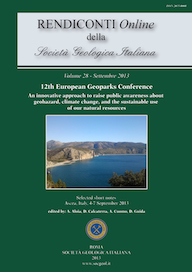
Rocky cliff landslide hazard: the Capo Noli Promontory case study (western Liguria, NW Mediterranean Sea)
A. Scarpati (*), G. Pepe (**), L. Mucerino (**), P. Brandolini (**) & M. Firpo (**)
(*) Consultant Geologist, Passeggiata Cadorna, 53, 17021, Alassio (SV), Italy. E-mail: a.scarpati@geosilt.com
(**) DISTAV - Dipartimento di Scienze della Terra, dell?Ambiente e della Vita. Università degli Studi di Genova. E-mail: giacomo.pepe@unige.it
Volume: 28/2013
Pages: 137-141
Abstract
The modern morphology of the Liguria coastal area was strongly modified by the interaction between the natural environment and human works. Presence of a steep cliffs, rarely alternating sandy-pebbly coastline, produces significant degrees of geo-hazard. On the 16th of January 2008 and again on the 29th of February 2009 rockfalls and topples affected the plunging rocky cliffs above the “Aurelia” main road at the promontory of Capo Noli (NW Mediterranean Sea). Detailed geo–structural and geo–mechanical surveys were carried out on two potentially unstable rocky cliff sectors. These surveys identified the main probable landslide types and instability factors. According to the rock mass mechanical properties and major geomorphological and structural features, a detailed rock mass quality and landslide hazard zoning has been achieved. In accordance with Rock Mass Rating (RMR) and Geological Strength Index (GSI) indexes, the surveyed rock mass usually has poor to very poor quality. Furthermore, the Rockfall Hazard Rating System (RHRS) index values have given evidence of a high probability of rockfall occurrence.
Keywords
Plunging cliffs, rockfalls, topples, rocky cliff hazard, Rockfall Hazard Rating System, western Liguria, Italy
Get Full Text